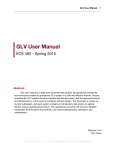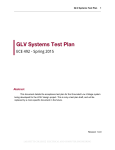Download GLV User Manual Draft - Sites at Lafayette
Transcript
GLV User Manual 1 Abstract This user manual is a high level document that explains all operational procedures and techniques needed to operate the GLV system in a safe and effective manner. Anyone operating the GLV system should be familiar with this document, and this document should be referred back to in the event of a problem with the system. This document is broken up by GLV subsystem, and each section contains an introduction, instructions on getting started, and an operational procedure. The operational procedure will include a detailed explanation of all functions and controls, user level troubleshooting, calibration, and maintenance. Revision 1.0.0 GLV Team LAFAYETTE COLLEGE │ ELECTRICAL AND COMPUTER ENGINEERING GLV User Manual 2 Table of Contents 1. Document Introduction 3 2. GLV Power 4 3. TSI 7 4. Safety Loop 11 5. VCI 13 LAFAYETTE COLLEGE │ ELECTRICAL AND COMPUTER ENGINEERING GLV User Manual 3 Document Introduction This document will outline how to set up all of the subsystems of the GLV system and how each system will work if it is properly functioning. The specific subsystems included in this document are the Power Box, TSI Box, VCI Box, and the safety loop. It also lists some basic troubleshooting methods for simple errors within the system. For issues that cannot be resolved from this manual, please reference the GLV maintenance manual. LAFAYETTE COLLEGE │ ELECTRICAL AND COMPUTER ENGINEERING GLV User Manual 4 The GLV Power subsystem provides power to all of the non-tractive systems in the electric vehicle. This includes the rest of the GLV subsystem, TSV AIRS, VSCADA computer, Motor, and Motor Controller. The Power subsystem consists of a Power Box, which houses the battery and a Power Monitor. This Power Box has a Charging Port, circuit breaker, and multiple LEDS. The function of all of these will be explained in the following sections. Explanations for important buttons and switches on the side panels of the car will also be provided. Setting Up the Power System The GLV Power System is located in the rear of the car with the Motor, Motor Controller, and TSI. The GLV Power System supplies power to the rest of the vehicle, but starting the Power System is dependent upon the side panels, Safety Loop, and Charging Port. In order for the user to activate the Power System, the Side Big Red Buttons (BRBs) must be closed and the GLV battery must have sufficient charge. If these criteria are met, then the user will use the GLV Master Switch (GLVMS) to activate the entire system. When the GLV battery is supplying power to the system, the GLV Power Light will be active. The only physical connection to the rest of the system is the GLV24 6-pin Molex connecter to the side panel of the vehicle. GLV Power Operational Procedures The GLVMS is the user’s on/off switch for the GLV Power System. All battery current flows through this switch; when deactivated, the GLVMS will disable power to all electrical circuits, including the alternator, lights, fuel pumps, ignition and electrical controls. The GLVMS is a red, rotary switch located on the ride side panel. The GLVMS is located next to the TSV Master Switch (TSVMS), which is discussed in Safety Loop section. Each Master Switch is clearly marked with the letters “GLV” or “TSV”. There is a GLV Power Light located next to the GLVMS that indicates whether the GLV Power system is actively powering the vehicle. Also located on the right side panel is one of the Side BRBs. The other Side BRB is located on the left side panel. Each of these buttons will be a red push-rotate switch that LAFAYETTE COLLEGE │ ELECTRICAL AND COMPUTER ENGINEERING GLV User Manual 5 separates the GLV battery from the rest of the GLV power lines.The BRBs will also kill the Accumulator Isolation Relays (AIRS). If a BRB is activated and the system is shutdown, the user must reset the BRB and then press the overall Reset to restore the state of the Safety Loop. The Reset button is located on the right side panel. There is also a BRB reachable by the driver in the cockpit. The function of this BRB is detailed in the Cockpit Box section. The GLV battery is a 24V, 10Ah, NiMH Battery Pack. The battery will be located in the Power Box which is in the rear of the car. It is here that the user can find the Charging Port, which is clearly labelled with “Charging Port”. The charger is a Smart 19.2V-24V NiMH/NiCad Auto-Detecting Charger. The charger has a 1.5A charging current and will cut-off power automatically when the battery is done charging. The charging process is as follows: 1. Plug the charger into a 120VAC power source. 2. Plug the other end of the charger into the Charging Port. When the battery is charging the Red LED will be lit on the charger. 3. When the battery is done charging the Green LED will be lit on the charger. Unplug the charger from the Charging Port. 4. If the Red LED is ever flashing, the charger has stopped because it has detected high temperatures. Unplug the AC power to reset the charger. According to the estimation Charging time (hours) = 1.2 x battery capacity (Ah) / 1.5, the 10Ah battery will take 8 hours to charge. There is also a Power Monitoring board in the GLV Power Box. There is an LTC4365 Overvoltage/Undervoltage Protection device for the two listed protections. This device allows outside resistor dividers to set comparator voltages to determine the threshold voltages. The upper limit has been set to 25V to prevent overvoltage. The lower limit is set to 20V to protect the battery from over-discharging. There is one Overvoltage LED and one Undervoltage LED, marked appropriately, next to the Charging Port to indicate these power monitoring faults. The device is simply a relay that opens when the thresholds are passed. No specific action must be taken by the user to reset the device. In the case of undervoltage, the battery should be charged. In the case of overvoltage, the user must determine how to correctly decrease the battery’s load. There is also overcurrent protection in the form of a Thermal Circuit Breaker Rated for 7A. The circuit breaker will be visible next to the Charging Port, and is the push to reset type. There is an Overcurrent LED located above the circuit breaker that is lit after an overcurrent fault. LAFAYETTE COLLEGE │ ELECTRICAL AND COMPUTER ENGINEERING GLV User Manual 6 Troubleshooting the Power System If the GLV Power System is active, the battery is supplying power to the low-voltage systems on the vehicle and the GLV Power Light will be on. If this light is ever off and the user desires the system to be active, the following steps should be taken. 1. Check the GLV Master Switch on the right side panel. If the switch is vertical, then it is off. Push and rotate the switch clockwise ninety degrees so that it remains horizontal. 2. Check the Side BRB on either side of the electric vehicle. If a BRB is pushed in, the Shutdown Circuit is active. Rotate the deactivated BRB clockwise until it “pops” out of the off position. 3. Check the Overvoltage LED on the Power Box. If this light is active, the user must determine what is causing the added load. The battery will not supply a voltage higher than 25V because it will damage the battery and other components of the vehicle. 4. Check the Under-voltage LED on the Power Box. If this light is active, the user should charge the battery according to the charging protocol listed in the previous section. 5. Check the Overcurrent LED on the Power Box. If this light is active, the user must reset the circuit breaker located next to the LED. The circuit breaker is push to reset. 6. If none of these solves the problem, there is a more serious issue present. Turn off the GLV Power system at the Master Switch and consult an expert. LAFAYETTE COLLEGE │ ELECTRICAL AND COMPUTER ENGINEERING GLV User Manual 7 The load controller serves as a high voltage interface between the TSV battery packs and the motor controller. The isolation relays act as a final switch in the high voltage line and the load controller gives the driver and crew members control over opening and closing that switch via the VSCADA system. The isolation monitoring device is used to monitor galvanic isolation between the high and low voltage components and it will trip the safety loop whenever the IMD detects a fault. The load controller also has several indicating lights that warn the driver and crew members about the status of vehicle. Setting up the TSI In this section we outline the steps that should be taken when setting up and connecting the load controller. These steps should be executed in the order that they are listed. 1. F Gnd: The fault ground terminal should be connected to the external GLV system ground to provide a secondary ground measurement for the isolation monitoring device. The socket connector mounted on the load controller is a Mouser 538-19-09-2018 and should be connected using a Molex 19-0901016 pin. 2. SL Out: The safety loop out should be connected into the safety loop (see the Safety Loop section of this document). The four pin socket connector that is used is a TE 350780-1 and should be connected using a TE 350779-1. 3. GLV24:: The grounded low voltage power and data bus must be connected to the GLV power box. This connection provides the power for the low voltage circuits in the load controller as well as a connection to the CAN data line. The six pin connector mounted on the load controller is a Mouser 571-14807050 and should be connected using a Mouser 571-14807040. 4. HV+: High voltage plus is the positive high voltage line from the TSV battery pack. The other side of this cable must be a power lock connection to the positive side of the battery pack. LAFAYETTE COLLEGE │ ELECTRICAL AND COMPUTER ENGINEERING GLV User Manual 8 5. Load+: Load plus is the positive high voltage line out of the load controller. The other side of this wire should be connected to the load. Voltage will only be present if the isolation relay is closed. 6. HV-: High voltage minus is the negative high voltage line into the load controller. The Other side of this wire should be a power lock connection the pack. 7. Load-: Load minus is the negative high voltage line out of the load controller. The other side of this wire should be connected to the load. Voltage will only be present if the isolation relay is closed. External Components of the TSI In this section we list and describe the external signals and components that are present used by the load controller. We describe how the signals should be interpreted and how the components should be used. 1. Power: This is a simple toggle switch. Power is supplied to the load controller when the switch is in the on position. 2. TSAL: Tractive system active light is the red LED indicator. It turns on when the tractive system is active. This is defined as either when the accumulator isolation relays are closed or when there is greater than five volts present on the tractive system. 3. IR1 Closed: Isolation relay 1 closed is the first yellow LED indicator. It turns on whenever the isolation relay across the positive high voltage line is closed. This means that voltage is present at the load. 4. IR2 Closed: Isolation relay 2 closed is the second yellow LED indicator. It turns on whenever the isolation relay across the negative high voltage line is closed. This means that voltage is present at the load. 5. GFD: LAFAYETTE COLLEGE │ ELECTRICAL AND COMPUTER ENGINEERING GLV User Manual 9 This is an LED that indicates that a fault has been detected by the insulation monitoring device. The light may also indicate that the IMD has detected a failure in its own operation. 6. GLV GMP: Ground low voltage ground measuring point is a banana jack connection directly to the low voltage system ground. This measuring point is required by the specifications and can be used in conjunction with the TSMP- to create a ground fault error. 7. TSMP+: Tractive system measuring point plus is a banana jack connection directly to the positive high voltage line. This measuring point is required by the specifications and can be used in conjunction with the TSMP- to measure voltage across the high voltage system. 8. TSMP-: Tractive system measuring point minus is a banana jack connection directly to the negative high voltage line. This measuring point is required by the specifications and can be used in conjunction with the TSMP+ to measure voltage across the high voltage system. It can also be used in conjunction with the GLV GMP to create a ground fault. 9. Fuse1: Fuse 1 is a 2 amp, 2AG fuse that exists between the negative high voltage side coming into the load controller and the low amperage measurement lines that the load controller needs. 10. Fuse2: Fuse 2 is a 2 amp, 2AG fuse that exists between the positive high voltage side coming into the load controller and the low amperage measurement lines that the load controller needs. Normal TSI Use In typical operation for discharging, the system will start up when the Power switch is put in the on position. At this point the Safety Loop will be open as well as the AIRs (accumulator isolation relays), so the red TSAL should be off. When the safety loop is closed, the AIRs close and high voltage is now present at the HV+ terminal of the load controller. Since the AIRs are closed the TSAL should turn on. When the user is ready to drive, the user must press the drive button on the SCADA interface. This will close the isolation relays in the LAFAYETTE COLLEGE │ ELECTRICAL AND COMPUTER ENGINEERING GLV User Manual 10 load controller and the two Yellow IR Closed LEDs should turn on. If the safety loop opens at any point all three LEDs should turn off. If it the Safety Loop was tripped by a fault detection in the IMD, then the IMD Indicator LED will turn on. Under normal shutdown procedures, the drive would not be able to reset the error from within the car. The Yellow IR Closed LEDs should turn off. Then, during shutdown the Safety Loop will open and the red LED should turn off. If any indication happens other than this normal use case, there may be an issue and the user is advised to consult an expert. Troubleshooting the TSI Blown Fuse: If the safety loop is closed and SCADA drive button has been pressed, the tractive system active light (top red light) should be turned on. If the previous two conditions have been met and the TSAL is not on then there is most likely a blown fuse. Follow these instructions to correct the problem. 1. Use banana jacks and a multimeter to read the voltage measurement across the tractive system measuring points. This should read approximately 0V (it may also be jumping around a lot between negative and positive voltages). 2. If there is a constant non-zero voltage across the measuring points, consult an expert and refer to the maintenance manual. The problem lies within the TSAL circuitry or connections. 3. Safely shutdown the system. 4. The fuse holders are located in the back of the safety box next to high voltage lines. They require a Phillips head screwdriver. 5. It is not possible to tell which of the two fuses have blown so unscrew both of them. Determine which one of them has blown (glass casing should be dark or black). 6. Replace the fuse with a new one and screw the fuses back into their places. 7. The system should now be ready to start again. Any other errors in the load controller need the consultation of an expert and reference to the maintenance manual. Issues to look out for are the following: 1. If any plastic connectors on the outside of the box break or get pushed into the box, refer to the maintenance manual. 2. The IR1 closed and IR2 closed LEDs respond to the same signal. If they are ever different, refer to the maintenance manual. 3. If any smoke is seen coming from the load controller or if the box has gotten unusually hot (>40 degrees Celsius), refer to the maintenance manual. 4. If it has been noticed that the isolation monitoring device has been constantly tripping or if a test has shown that it does not trip (indicated by the status of the of the safety loop), consult the maintenance manual. LAFAYETTE COLLEGE │ ELECTRICAL AND COMPUTER ENGINEERING GLV User Manual 11 The Safety Loop keeps the electric vehicle in a state of safe operation and allows the driver, surrounding personnel, and system components to shutdown the system in case of emergency or system failure. This user’s manual will detail the connections of the Safety Loop, and the processes involved in engaging and disengaging the Safety Loop. Setting Up the Safety Loop The Safety Loop starts with the Safety Circuit. The Safety Circuit is housed within the TSI Box. From here the Safety Loop flows throughout the entire system. It must connect with each of the following vehicle systems: ● ● ● ● ● Vehicle Computer Interface Cockpit Box (VCI) Brake Over Travel Switch (BOTS) Tractive System Battery Packs (all four) Tractive System Master Switch Motor System Each of the components have two Safety Loop connects. This lets the Safety Loop run serially through each of the required systems. The Safety circuit must begin at the TSI and terminate with a safety loop cap. The specific order of these connections does not matter as long as each is connected to the line and the final system has a safety loop cap. Engaging the Safety Loop There are multiple checks that need to be looked over before the Safety Loop can be properly engaged. Once the system is wired as described above, check the that the GLV Power light, the BOTS, and Master Switches to ensure that they are all in their proper state. The VSCADA safety loop relay needs to be closed and the TSI will need to indicate that the IMD is in its proper state. Once these have been verified the Safety Loop is ready to be engaged. The user can now press and hold the green reset button for one second. If the safety loop is fully closed, a green safety loop LED will be lit. If this light does not come on, recheck the status of the wiring, the IMD, BRBs, BOTS, and Master Switches. If the problem persists, simply replacing the fuse (2AG 6A fuse) is another option. If this does not engage the green LED, there is another maintenance issue that should be explored. LAFAYETTE COLLEGE │ ELECTRICAL AND COMPUTER ENGINEERING GLV User Manual 12 Opening the Safety Loop The Safety Loop should only be opened in case of emergency while energized. If the Safety Loop is opened repeatedly while current is flowing through it, the life of the AIRs is shortened. The fastest way to open the Safety Loop is by pressing one of the BRBs or by pressing the yellow test button on the safety controller which opens the loop as well. It is recommended, and easier, to use the BRBs instead of the test button in an emergency situation. If there is a fault in the system in the IMD, tractive system cells, VSCADA, BOTS, or motor controller, the safety loop will shutdown automatically open as per the specifications. After Opening the Safety Loop If the Safety Loop is ever opened, the user should find the source of the failure. Sources of failures include: ● ● ● ● ● ● ● ● IMD Fault AMS Fault BOTS flipped VSCADA error Motor Controller Safety Loop physically disconnected Loss of power from the GLV Master Switches Before resetting the Safety Loop, the user should fully inspect each element to determine the cause of the Safety Loop opening. Do not simply reset the system with the green button without determining the original source of fault. LAFAYETTE COLLEGE │ ELECTRICAL AND COMPUTER ENGINEERING GLV User Manual 13 The Vehicle Computer Interface will deliver data from sensors located throughout the car to the VSCADA system. Data from theses sensors will be converted from analog to digital data using microprocessors and then formated for the cockpit display by the VSCADA computer. The Ready-to-Drive sound speaker will also be designed and implemented as a safety feature for the electric car. This user’s manual will detail the connections of the Vehicle Computer Interface, and some troubleshooting assistance. Setting Up the VCI Box In order for proper operation of the Vehicle Computer Interface, the VCI box must be set up as follows in the specific order noted. 1. 2. 3. 4. Connect the box to the cockpit via the Cockpit Bus port. Connect the box to the TSV system via the TSV Data ethernet connector. Connect the box to the TSI box via the Load Controller 3-pin Molex connector Integrate the box into the safety loop via both Safety Loop (SL) 4-pin Molex connectors. 5. Connect the box to the GLV power and data line via the GLV24 6-pin Molex connector. Normal VCI Operation In normal operation the VCI system, a green power light will appear when the system is properly powered. Data from the VSCADA computer will be displayed on the cockpit display. The Safety Loop light should not be lit, if no critical errors were found. Troubleshooting If the cockpit display and/or VSCADA computer are not starting: ● Check connection to the GLV24 line and that the line is supplying power ● Check that the cockpit display bus is connected properly ● Reset the VSCADA computer If the Ready-To-Drive sound is inaudible or quiet: LAFAYETTE COLLEGE │ ELECTRICAL AND COMPUTER ENGINEERING GLV User Manual 14 ● Use a voltmeter to make sure the subsystem is receiving power ● If the speaker is emitting a low volume sound then adjust the amplifier as needed ● If no sound is being emitted remove the speaker from the system and test to see if it is still working ● If the speaker is operating properly then reinstall the speaker and replace the amplifier ● If there is no improvement of the system then further analysis of the circuit by an engineer is required If the displayed measurements are no longer working or noticeably inaccurate ● Ensure that the system is properly connected to GLV24 ● No change in the output, check the microprocessor to see if it is correctly converting the data, if it is not replace the microprocessor LAFAYETTE COLLEGE │ ELECTRICAL AND COMPUTER ENGINEERING





























